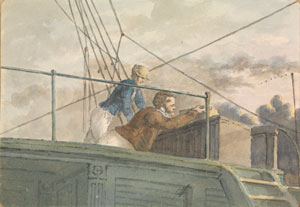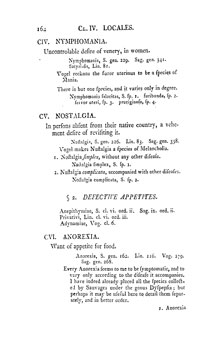
What Nostalgia Knew

Two sailors on the upper deck of a ship,
seen from below by Thomas Streatfeild
© National Maritime Museum,
Greenwich, UK
Nostalgia might appear a simple enough thing: a wistful longing for a past time or place, whose virtues are often retrospection’s construct. In a culture that measures accomplishment by innovation, nostalgia can seem a Siren song whose illusory beauty the enlightened thinker is bound (mast or not) to resist.
During the eighteenth century, and well into the nineteenth, if one met a nostalgic sufferer, it would have seemed more suitable to react with alarm to a potentially fatal condition and refer the patient to a physician. For, as is sometimes remembered (but often not), nostalgia was at first a disease, whose original context and discourse were medical. The word was coined in 1688 from the Greek nostos (“homecoming”) and algia (“pain,” “suffering”) by a Swiss physician, Johannes Hofer, who sought to give the vernacular Heimweh (“homesickness”) international prestige and a place in contemporary nosologies (disease taxonomies on the model of botanical classifications). Once classified, nostalgia soon became the widely known, internationally reported disability of soldiers, sailors, exiles, emigrants, explorers, and others on the move, usually involuntarily. It reached epidemic proportions during the French Revolution and Napoleonic wars, when military leaders and surgeon-generals complained that their men were not dying on the battlefield for their country but instead deserting to return to it. British navy captains and ship doctors had long reported that nostalgic sailors at sea, watching for their unseen land, saw its green fields in the waters and threw themselves in. To them, this was more than desire gone overboard—it was not propitious for nation building.
Of course, the painful longing for homecoming existed before Hofer and 1688. I mentioned the Sirens, and one thinks of Odysseus and his crew. But its medicalization as a physiological pathology was new, signaling that it had become a problem, as not before, in need of a remedy. Nostalgia was a disorder of mobility—and practical impediment—in a world order increasingly premised on mobility. The years from 1701 to 1815 witnessed a remarkable convergence of newly systematized modes and routes of transportation, increased circulation of goods and men, emigration, rural depopulation, scientific exploration and nearly uninterrupted warfare on a global scale. Moreover, unlike melancholia (the disease of scholars and contemplatives), nostalgia was the disabling illness of peasants, the new urban poor, and homeless or repatriated populations, traversing classes and levels of education. What I have found most striking and consequential, however, is the symmetry between those conditions of historical mobility and the language of concurrent medical discourse. In the wake of Newton’s physics and seventeenth-century discoveries about the nervous and circulatory systems, the bio-medical questions of note concerned the source and location of material “motions” within the body, the degree to which these were subject to volition, and the body’s capacity to respond to external stimulus. Nostalgia acquired an elaborate somatic profile and set of physical symptoms, all the result of slowed vital motions: sluggish heart rate and circulation, impaired digestion, irregular respiration, brain lesions and more. It was motion sickness in a double sense: the corollary of a radical increase in the mobility of persons and populations, in turn represented as the decreased or irregular motions within bodies. Janus-faced, it mediated between physiology and the unfolding, unstable historical moment.

William Cullen's "Nosology"
(1800 edition)
Nostalgia was thus about the present before it became about the past. It registered history, or what Raymond Williams called “history in solution,” on the pulse—and it was no simple matter. From the University of Edinburgh, medical capital of the later eighteenth century, the leading professor and physician William Cullen aspired to gather previous taxonomies and, sharing his friend (and patient) Adam Smith’s “love of system,” to assimilate them into his own: a key to all nosologies. Cullen placed nostalgia among the “false or defective appetites”—along with bulimia, pica, polydipsia, nymphomania, and other desires deemed pathological. As if aware that something was awry, he added an apologetic footnote, acknowledging that “Nostalgia alone, if it be really a disease, cannot properly come under this class, but I could not well separate this uncertain disease from the other Dysorexiae.” Nostalgia eluded the system.
What interest might “this uncertain disease” hold for scholars today—especially, perhaps, humanities scholars, a group now at risk of receiving the unwelcome if not fatal diagnosis of nostalgia and of becoming subject to a cure-by-marginalization? Here are two linked suggestions, but there are more:
1) We strive to be interdisciplinary—we must walk between the north and south sides of campus. This was not the case when “science” still meant general knowledge, rather than a subject or subset thereof. Throughout the eighteenth century, medicine and the life sciences in particular developed in the same matrix as the new discipline then describing itself as the “science of sensuous perception”—aesthetics, or in Britain (wary of foreign terms) “poetry” or “criticism.” William Wordsworth’s epithet for “Poetry” in 1800, “the science of feelings,” might have been Cullen’s for physiology or neurology. Authors of belles-lettres and criticism worked in the same circles as medical writers and practitioners and drew on shared principles of association. Sometimes they were the same person: Schiller was a medical student at the Military Academy of Stuttgart, attending to nostalgic cadets, before writing On Naïve and Sentimental Poetry and On the Aesthetic Education of Man. Albrecht von Haller, Oliver Goldsmith, Tobias Smollett, Erasmus Darwin, Goethe, Keats, and Novalis were authors with variously active careers in medicine, biology, or natural history.
In their literary theory and practice, these and other figures were just as interested in what moves people, of course, even if they posed and answered the question differently. Medical science’s unresolved confrontations with the causes and effects of mobility were thus absorbed, I’d suggest, into the developing ground of aesthetic theory, persisting there in questions about the means and ends of producing emotion, ethical action, or political movement, or in debates about the role of form in the spatial and temporal movement of reading. The very term nostos (“homecoming”) also designates the end of a poem—which is to say that nostalgia’s longing for return is also a desire for the feeling of form. Yet, while working in intellectual or literary proximity to medical science, poets, novelists, or critics were not bound to the same therapeutic agenda, and so they could part ways, redirecting shared questions. Wordsworth, for example, made an art of displaying the incommensurability between the human effects of geopolitical mobility and the logic of cure; his strange anti-climatic endings relentlessly thwart the desire for conclusion. Are disciplines shaped by the ways in which they respond to disturbances in the precarious ecology between mind and world—which, at root, nostalgia was? A large question, but a question nonetheless.
2) The “-algia” of nostalgia need not attach itself to a literal home or place. In a 1778 treatise on “experience in physic,” and in the midst of a discussion of whether the Swiss are particularly prone to nostalgia (he thought not), one of Cullen’s contemporaries, J. G. Zimmerman, unexpectedly swerves from his argument to note: “Every Swiss feels, as I do, the Nostalgia, under a different name, tho’ at home, whenever he thinks he should live better in any other country.” Zimmerman was not an especially radical thinker—he was chief physician to George III (a hopeless task). But here he opens up the sheer counterfactuality of nostalgia, its dwelling in the possibility of things not as they are. In this sense, Zimmerman leads us beyond the association of nostalgia with liberal sentimentality or later fascist celebrations of blood and soil. His comment provides perspective and some prehistory for Foucault’s unsentimental acceptance of nostalgia as a good “on the condition that it is a way to have a thoughtful relation to your own present,” or Adorno’s more extreme statement in Minima Moralia: “it is part of morality not to be at home in one’s home.”
Nostalgia “under another name” and “at home” is—or can be—criticism.
Kevis Goodman is Associate Professor of English at UC Berkeley. Her current project is a book on the poetics and sciences of mobility during the 18th and early 19th centuries.
This article can be found in the September/October 2011 newsletter.